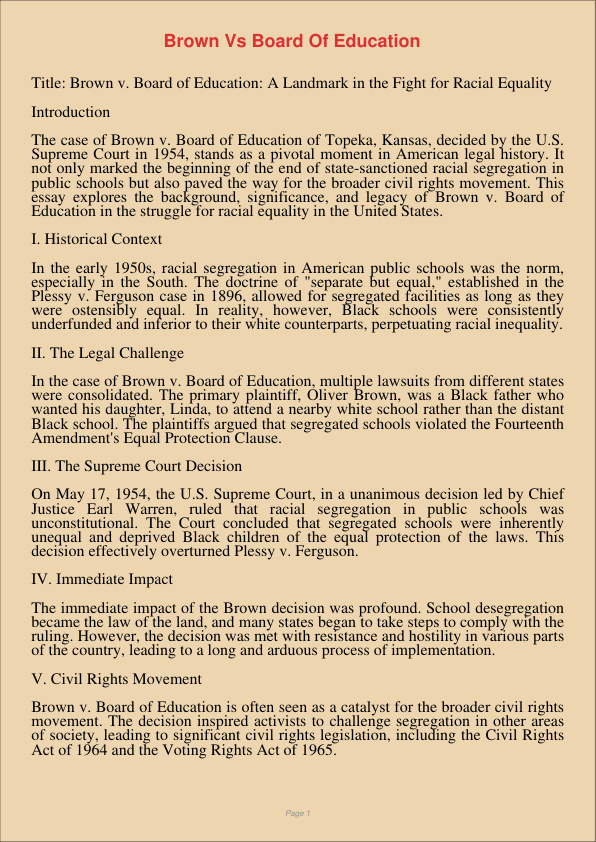Brown Vs Board Of Education
Jan 12, 2024
brown vs board
education
Marketing
Family & Consumer Science

Title: Brown v. Board of Education: A Landmark in the Fight for Racial Equality
Introduction
The case of Brown v. Board of Education of Topeka, Kansas, decided by the U.S. Supreme Court in 1954, stands as a pivotal moment in American legal history. It not only marked the beginning of the end of state-sanctioned racial segregation in public schools but also paved the way for the broader civil rights movement. This essay explores the background, significance, and legacy of Brown v. Board of Education in the struggle for racial equality in the United States.
I. Historical Context
In the early 1950s, racial segregation in American public schools was the norm, especially in the South. The doctrine of “separate but equal,” established in the Plessy v. Ferguson case in 1896, allowed for segregated facilities as long as they were ostensibly equal. In reality, however, Black schools were consistently underfunded and inferior to their white counterparts, perpetuating racial inequality.
II. The Legal Challenge
In the case of Brown v. Board of Education, multiple lawsuits from different states were consolidated. The primary plaintiff, Oliver Brown, was a Black father who wanted his daughter, Linda, to attend a nearby white school rather than the distant Black school. The plaintiffs argued that segregated schools violated the Fourteenth Amendment’s Equal Protection Clause.
III. The Supreme Court Decision
On May 17, 1954, the U.S. Supreme Court, in a unanimous decision led by Chief Justice Earl Warren, ruled that racial segregation in public schools was unconstitutional. The Court concluded that segregated schools were inherently unequal and deprived Black children of the equal protection of the laws. This decision effectively overturned Plessy v. Ferguson.
IV. Immediate Impact
The immediate impact of the Brown decision was profound. School desegregation became the law of the land, and many states began to take steps to comply with the ruling. However, the decision was met with resistance and hostility in various parts of the country, leading to a long and arduous process of implementation.
V. Civil Rights Movement
Brown v. Board of Education is often seen as a catalyst for the broader civil rights movement. The decision inspired activists to challenge segregation in other areas of society, leading to significant civil rights legislation, including the Civil Rights Act of 1964 and the Voting Rights Act of 1965.
VI. Ongoing Challenges
While Brown v. Board of Education was a groundbreaking decision, it did not lead to an immediate end to racial disparities in education. Desegregation was often met with fierce opposition, and many schools remained effectively segregated in practice. Racial disparities persist in education, and issues such as school funding, achievement gaps, and resegregation continue to be challenges today.
VII. Legacy
The legacy of Brown v. Board of Education is undeniable. It remains a symbol of progress and a reminder of the ongoing struggle for racial equality in the United States. The decision not only transformed the education system but also laid the groundwork for a broader movement that sought to challenge systemic racism in all aspects of American society.
Conclusion
Brown v. Board of Education was a landmark moment in the fight for racial equality in the United States. It demonstrated the power of the legal system to challenge deeply entrenched systems of discrimination and set the stage for a broader civil rights movement. While the decision did not immediately eradicate racial disparities in education, it sent a clear message that segregation was unconstitutional and fundamentally unjust. The legacy of Brown v. Board of Education endures as a symbol of progress and a call to continue the work of dismantling systemic racism in all its forms.